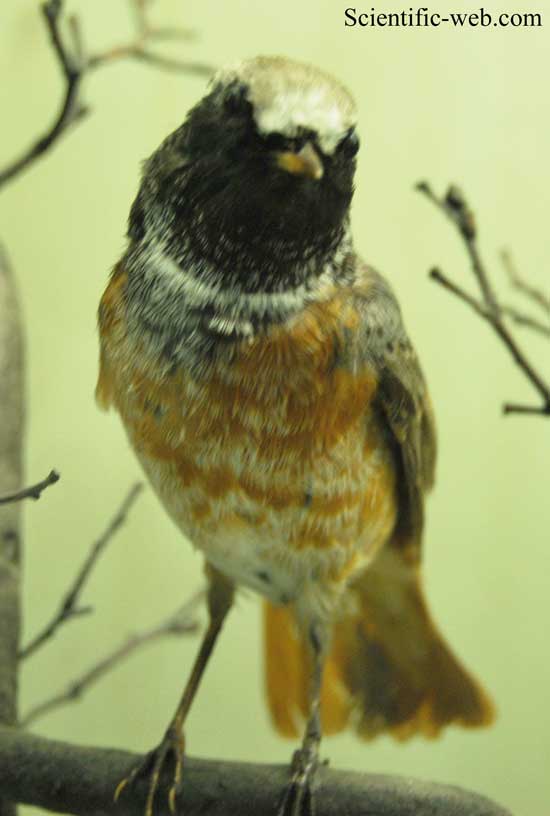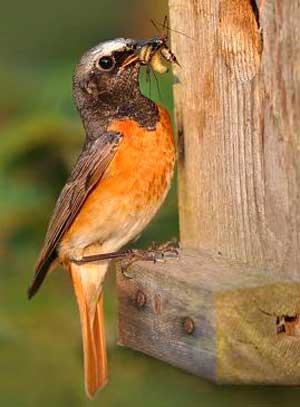Phoenicurus phoenicurus (*) Cladus: Eukaryota
Phoenicurus phoenicurus (*) Name Phoenicurus phoenicurus (Linnaeus, 1758) Vernacular Names
Systema Naturae ed.10 p.187 The Common Redstart (Phoenicurus phoenicurus), or often simply Redstart, is a small passerine bird in the redstart genus Phoenicurus. Like its relatives, it was formerly classed as a member of the Thrush family (Turdidae), but is now known to be an Old World flycatcher (Muscicapidae). Description The Common Redstart shows some affinity to the European Robin in many of its habits and actions. It has the same general carriage, and chat-like behaviour, and is the same length at 13–14.5 cm long but slightly slimmer and not quite as heavy, weighing 11–23 g. The orange-red tail, from which it and other redstarts get their names ("start" is an old word for "tail"), is frequently quivered. Among common European birds, only the Black Redstart (Phoenicurus ochrurus) has a similarly coloured tail.[1][2] The male in summer has a slate-grey head and upperparts, except the rump and tail, which, like the flanks, underwing coverts and axillaries are orange-chestnut. The forehead is white; the sides of the face and throat are black. The wings and the two central tail feathers are brown, the other tail feathers bright orange-red. The orange on the flanks shades to almost white on the belly. The bill and legs are black. In autumn, pale feather fringes on the body feathering obscures the colours of the male, giving it a washed-out appearance. The female is browner, with paler underparts; it lacks the black and slate, and the throat is whitish. It is a summer visitor throughout most of Europe and western Asia (east to Lake Baikal), and also in northwest Africa in Morocco. It winters in central Africa and Arabia, south of the Sahara Desert but north of the Equator, from Senegal east to Yemen. It is widespread as a breeding bird in Great Britain, particularly in upland broadleaf woodlands and hedgerow trees, but in Ireland it is very local. The males first arrive in early to mid April,[3] often a few days in advance of the females. Five or six light blue eggs are laid during May, with a second brood in mid summer in the south of the breeding range. It departs for Africa between mid-August and early October. It often feeds like a flycatcher, making aerial sallies after passing insects, and most of its food consists of winged insects. The call is chat-like and the alarm a plaintive single note, wheet, like that of many other chats.[1] The male’s song is similar to that of the Robin, but never more than a prelude, since it has an unfinished, feeble ending. Habitat
In England, where it has declined by 55% in the past 25 years, the Forestry Commission offers grants under a scheme called England's Woodland Improvement Grant (EWIG); as does Natural Englands Environmental Stewardship Scheme.[4] Taxonomy Two subspecies are accepted. The nominate P. p. phoenicurus is found all over Europe and reaches into Siberia. To the southeast, subspecies P. p. samamisicus is found from the Crimean Peninsula through Turkey, the Middle East, and into Central Asia. It is slightly smaller than P. p. phoenicurus and in adult males has white outer webs in the remiges to some extent, forming a pale to whitish wing-patch similar to the one seen in Black Redstart and Daurian Redstart. This patch is also present but less conspicuous in immature males, and sometimes in adult females. The subspecies intergrade widely in Turkey and the southern Balkans.[1][2] The closest genetic relative of the Common Redstart may be the Moussier's Redstart, though incomplete sampling of the genus gives some uncertainty to this.[5] Its ancestors were apparently the first redstarts to spread to Europe; they seem to have diverged from the Black Redstart group about 3 mya, during the Piacenzian.[6] Genetically, Common and Black Redstarts are still fairly compatible and can produce hybrids that appear to be healthy and fertile, but they are separated by different behaviour and ecological requirements so hybrids are very rare in nature.[7] References 1. ^ a b c d Hoyo, J. del, et al., eds. (2005). Handbook of the Birds of the World, vol. 10. Barcelona: Lynx Edicions. pp. 771. ISBN 84-87334-72-5. Source: Wikipedia, Wikispecies: All text is available under the terms of the GNU Free Documentation License |
|


